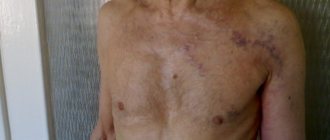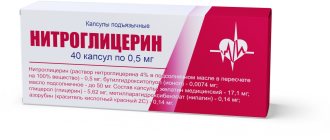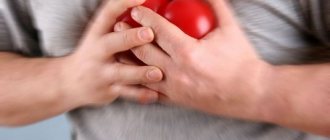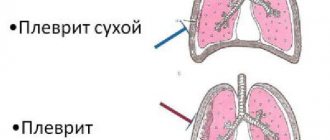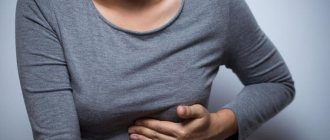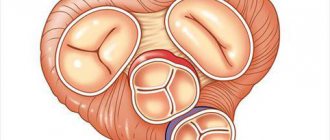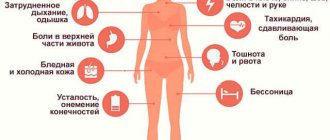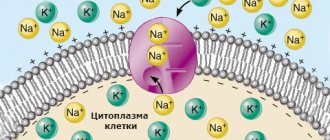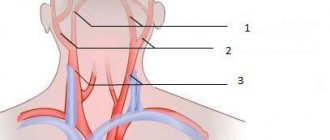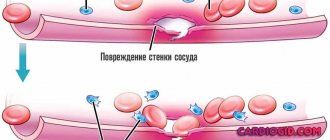Discomfort on the right
Often a person is able to listen to his feelings and determine where exactly the pain is localized. Often the discomfort is widespread, and this is difficult to do. But if a person clearly feels a tingling sensation in the chest on the right, then there is a high probability that the cause lies in one of the following conditions:
- Injury resulting from vigorous physical activity. If, for example, a person’s body is not prepared for high loads, then he can simply stretch his chest muscles.
- Fractured ribs. This is usually indicated by sharp tingling sensations. If a person coughs or squeezes that area, the pain will become much stronger.
- Injury. If this is indeed the reason, then a bruise will be visible at the place where the discomfort is localized.
- Pathologies of the respiratory or gastrointestinal tract.
If in the first three cases everything is more or less obvious (it is difficult not to notice the fracture), then in the case of diseases it is a little more complicated. Therefore we should dwell on them.
Why does a tingling sensation appear in the mammary gland?
Tingling in the mammary gland is the sensation of a prick in the chest, either single and sharply repeated at certain intervals, or multiple pricks of varying severity.
Sometimes it’s like minor pricks from small needles. This symptom appears quite often and has completely different causes.
Causes not related to the mammary gland
Sometimes the cause of pain is not in the chest at all. Tingling sensations can manifest themselves in:
- diseases of the cardiovascular system;
- osteochondrosis;
- intercostal neuralgia.
Pain in the heart is often stabbing in nature. With osteochondrosis, compression of the nerve endings occurs, and the pain radiates to different parts of the body, since the nerve endings of all organs pass in the spine. The pain with intercostal neuralgia is usually sharp, cramping, and surrounds the ribs. But there are also piercing ones.
Go through a medical examination, do the necessary research and check if you have these diseases.
Advice from a dermatologist... Itching, rashes and flaking of the skin signals that the body is SCREAMS at the top of its lungs about problems. What these symptoms mean, we asked the chief physician Sergei Vladimirovich Rykov... Read more...
Natural hormonal causes
Tingling is caused by changes in hormone levels. For example, when there is an excess level of estrogen, the glandular tissue of the breast grows, and when there is an excess level of progesterone, the tissue tends to retain water. Due to all these processes, the volume of breast tissue increases.
It can put pressure on nerve endings or blood vessels, impeding blood circulation. What causes tingling. Therefore, tingling is sometimes observed during pregnancy, in the middle of the cycle, on the eve and during menstruation, and during menopause.
During lactation, such sensations are often associated with pressure on the nerve endings and skin of milk, and disappear with sufficient expression. The listed symptoms always require preventive examination and consultation with a doctor, but in general they are considered normal. Even a slight burning sensation and pain in the listed conditions of the body are considered normal if doctors do not detect pathologies.
Such sensations also occur in adolescents during puberty and breast development. This is mostly normal.
A burning sensation in the mammary gland can be the result of injury to tissues or blood vessels from a blow or simply pressure from uncomfortable underwear. If a lot of time has passed after the exposure and the area is still burning, you need to see a mammologist.
Pathologies
Unpleasant sensations and tingling in the chest may be a sign of:
- Tingling, burning and pain are often caused by mastopathy. This disease occurs as a result of the proliferation of glandular breast tissue under the influence of fluctuations in hormone levels. A striking symptom is pain, regardless of the phase of the cycle, and the presence of small compactions - nodules that are easily palpable.
- Diseases of the endocrine system - for example, the thyroid gland. Improper production of hormones seriously affects the entire body, including causing pain and pathological processes in the mammary gland.
- The presence of a neoplasm - for example, a cyst. An urgent examination is needed to confirm its benignity.
- Inflammation of the sebaceous gland - a clogged gland on the skin becomes inflamed, and first manifests itself as a tingling sensation, and then, after a couple of hours or days, a red, inflamed lump becomes noticeable.
Tingling during menopause, when a woman has already stopped her period, often indicates a pathological process in the chest, so always check for any alarming symptom of the body.
It is also worth remembering that men are also susceptible to hormonal effects on the condition of their breasts. They may also develop new growths that require examination.
A burning sensation may be a symptom of the presence of a focus of inflammation. If, in addition, the breast hurts, becomes red and inflamed, and becomes hot, this indicates acute inflammation - mastitis. It occurs when an infection occurs, as a complication of viral diseases, or as a result of a cold and hypothermia.
What to do
Whatever the cause of the problem, natural condition or pathology, the body can be helped.
To reduce or completely eliminate discomfort, follow these tips:
- increase physical activity, a sedentary lifestyle is the enemy of the body, and fat deposits accumulate excess estrogen, which causes chest pain;
- stick to a healthy diet - a minimum of fatty, fried and smoked foods, and a maximum of fish rich in omega-3 fatty acids, as well as fresh vegetables and fruits;
- organize healthy sleep and a minimum of stressful situations;
- try to spend more time in nature, in the fresh air;
- do not drink more than 1 cup of coffee per day - caffeine reduces the amount of progesterone in the body and increases estrogen, that is, it causes hormonal imbalance;
- wear comfortable underwear;
- practice a contrast shower - from cool to warm (but not hot!), this water massage hardens and improves blood circulation.
Other treatment measures
The above measures will benefit not only breast health, but the entire body. With lactostasis, frequent latching of the baby to the breast and the use of a breast pump will help you.
Mastitis can be treated only under the supervision of a doctor; antibiotics are prescribed without fail, since without treatment this condition is very dangerous.
If any unpleasant symptoms appear, get examined. Consult a gynecologist, endocrinologist and mammologist. Get an ultrasound, mammogram, tests for hormones and tumor markers.
It is best to come for a breast examination from the 6th to the 12th day of the cycle, since it is in a natural state - it is not affected by menstrual periods and has not yet begun to be affected by ovulation.
The days of the visit are adjusted depending on the woman’s cycle - if your period ends earlier and ovulation begins later, come for an examination any day in this interval.
As a preventative measure, such examinations should be carried out every year. After 35-40 years - twice a year. And in the near future, if something starts to bother you.
There are many reasons for this condition. Some of them are natural and harmless, while some require prompt medical intervention. Contact a specialist and don’t delay.
Conclusion
If you notice a coincidence of sensations with the phases of the cycle, contact a mammologist or gynecologist.
Doctors warn! Shocking statistics - it has been established that more than 74% of skin diseases are a sign of parasite infection (Accarida, Giardia, Toxocara).
Worms cause enormous harm to the body, and the first to suffer is our immune system, which should protect the body from various diseases.
The head of the Institute of Parasitology shared the secret of how to quickly get rid of them and cleanse your skin, it turns out that it’s enough... Read more...
If there is no connection with cyclic changes, first contact an experienced therapist and undergo all tests and studies of the organs surrounding the sore spot. Take care of your health; any disease is easier to cure in its early stages.
Source: https://venbolezni.com/problemy-u-zhenshhin/pochemu-poyavlyaetsya-chuvstvo-pokalyivanie-v-molochnoy-zheleze.html
Pneumonia
With this acute lung injury, tingling in the chest often occurs. Pneumonia is caused by a bacterial infection. The disease can also develop due to chest trauma, exposure to allergens or toxic substances. At risk are people who smoke, as well as anyone who abuses alcohol.
In addition to tingling in the chest on the right side, the following symptoms are observed:
- High temperature (more than 39 °C).
- Chills.
- Weakness.
- Dyspnea.
- Dry and unproductive cough, which is replaced by “rusty” sputum on days 3-4.
- Cyanosis of the nasolabial triangle.
- Hyperemia of the skin.
- Rapid shallow breathing.
- Frequent, arrhythmic pulse, low blood pressure, muffled heart sounds.
For diagnosis, ultrasound of the pleural cavity, echocardiography, X-ray of the lungs, blood and urine tests, and sputum analysis are performed.
Treatment is carried out in a hospital, in the pulmonology department; bed rest, a high-calorie diet, and plenty of fluids are required. In serious cases, oxygen inhalations are prescribed.
But the main principle of treatment is antibacterial therapy. Doctors also often prescribe antihistamines, expectorants, mucolytics, antipyretics and immunostimulants.
Why it hurts in the chest: natural and pathological causes
The cause of tingling in the chest can be both normal physiological changes in the body (pregnancy, menstrual cycle) and the presence of chronic diseases. At the same time, based on the nature of the painful sensations, it is very problematic to exclude one pathology and confirm another. To do this, you need to evaluate the totality of symptoms inherent in the disease.
Natural causes
Discomfort in the chest in women can have physiological causes that are not dangerous to health. Tingling occurs on certain days of menstruation, during breastfeeding and pregnancy.
Immediately before menstruation or in the first days of menstruation, a woman may feel tingling in the mammary gland along with other symptoms: emotional instability, swelling, heaviness of the glands, pain in the lower abdomen.
This symptomatology is caused by changes in hormonal levels, tingling is observed cyclically. It does not require medical consultation, except when such menstrual symptoms interfere with the woman’s normal functioning.
During pregnancy, the gland enlarges due to the growth of its glandular layer. Unpleasant tingling sensations may result from compression of nerve endings. Usually, discomfort in the chest bothers the expectant mother in the last weeks of pregnancy.
During breastfeeding, the mammary glands actively function and produce milk. This process is often accompanied by tingling, even pain.
Uncomfortable symptoms are especially noticeable during breastfeeding in the first 1.5–2 months of lactation. Then the milk production process returns to normal.
At this time, it is important not to miss the first signs of mastitis, which is accompanied by the appearance of lumps and chest pain.
Mastitis
Breastfeeding mothers are usually susceptible to mastitis. However, there are cases of the development of pathology in men, girls and women who do not breastfeed. With breastfeeding, the cause of mastitis is the entry of bacteria into the gland through microtrauma of the nipple.
The immune system, weakened during the postpartum period, is not able to cope with the causative agent of mastitis. The development of the disease occurs rapidly.
Lactostasis (constant stagnation of milk in the milk ducts due to insufficient emptying of the breast) can also lead to mastitis.
Symptoms of the development of mastitis include breast swelling, stabbing and bursting sensations. Redness of the skin is observed, the breasts cease to be soft. Often accompanied by an increase in temperature.
Enlarged lymph nodes can be felt in the armpit. With mastitis, one breast is affected; very rarely, both glands are affected at the same time.
Mastopathy
With mastopathy, growth of gland tissue is observed. At the first stage of the disease, the disease proceeds latently, there is no pain. As the pathology develops, the breasts become painful, tense, and increase in size. Soreness appears in different ways - tingling, aching pain. Mastopathy can affect either one gland or both at the same time.
Pain due to mastopathy is characterized by cyclicality: it intensifies as menstruation approaches. Moreover, the pain syndrome reaches its peak on the first day of menstruation. Often the pathology is accompanied by discharge from the nipple. They are white or transparent.
Endocrinological diseases
Disturbances in the endocrine system can lead to an imbalance in hormone levels. This can provoke pain in the chest in the form of tingling. In addition to chest pain, other symptoms are observed:
- muscle weakness;
- general fatigue;
- frequent urination;
- sudden weight gain or loss;
- constant thirst;
- bowel disorder (diarrhea, colitis), etc.
Heart diseases
Diseases of the cardiac system are characterized by tingling in the left chest. If intense pain is localized in the middle and turns into a burning sensation, this may be the first manifestation of a heart attack.
In the presence of cardiac diseases, manifested by tingling in the chest, the following symptoms are observed:
- dizziness;
- increased heart rate;
- fast fatiguability;
- shortness of breath, an attempt to take a deep breath provokes increased pain;
- acute pain on the left, which occurs periodically in a calm state or under certain circumstances.
Angina pectoris is characterized by paroxysmal pain. They are systematic, last for 5–30 minutes, and radiate to the left hand. Pain syndrome can be provoked by an emotional outburst or physical activity.
Intercostal neuralgia
A sign of neuralgia is pain on the left or right side of the chest. The nature of the pain varies: from mild tingling to severe, constant pain.
The following symptoms are also characteristic of intercostal neuralgia:
- numbness of the affected areas;
- muscle tension;
- convulsions;
- "goosebumps;
- an attack is provoked by physical activity.
Tingling with neuralgia is not easy to distinguish from pain with cardiac disorders. Differences between diseases:
- When the heart is damaged, changes in heart rate and blood pressure are observed.
- If the heart is stabbing, the position of the patient’s body will not affect the strength of the pain. With intercostal neuralgia, movement, even breathing, provokes an increased attack of pain.
Spinal problems
Tingling in the chest area can also be caused by diseases of the spine. This pain is localized in the middle or upper part of the chest. The most common diseases of the spine that cause tingling are osteochondrosis, scoliosis, and intervertebral hernia.
With osteochondrosis, the pain is aching or shooting in nature, intensifies with movement, coughing, sneezing. Slow reflexes and muscle tension are observed.
Chest pain can be caused by a herniated disc in the thoracic region. The disease is also characterized by frequent and severe dizziness, numbness of various parts of the body, and difficulty in taking a certain position.
Tumors
The cause of tingling in the mammary gland can be the presence of a tumor, either benign or malignant.
In the presence of a benign tumor, the patient does not complain of pain for a long time, but feels slight discomfort in the area of tumor development.
A malignant tumor in the chest develops rapidly, pain varies in nature and intensity. The pathology is also characterized by a number of other symptoms:
- Abundant secretion from the nipple, blood may be present.
- The skin on the sore breast begins to tighten, the breast itself is often deformed, and the boundaries of the neoplasm can be seen externally.
- The nipple thickens and becomes retracted.
With breast cancer, there is an increase in lymph nodes in the armpit. To the touch, the lymph nodes become like a bunch of grapes. When you raise your arms, there is pain in the armpits.
Diagnostics
For a comprehensive diagnosis of the pathology that provokes tingling in the chest, you should contact the following specialists:
- therapist;
- mammologist;
- endocrinologist;
- surgeon;
- neurologist;
- oncologist.
To have an idea of the internal course of the disease, the doctor will recommend undergoing the following types of examination:
- general blood and urine analysis;
- blood to identify tumor markers for suspected cancer;
- blood test for hormone levels to rule out thyroid dysfunction;
- blood test for sugar levels.
The doctor performs an external examination of the chest, examines the glands for compaction, swelling, and asymmetry. Conducts palpation of the nearest lymph nodes.
The patient will also be referred to hardware examination methods. Ultrasound of the breast allows you to detect the presence of cysts, lumps, and determine their nature, consistency, and shape.
Ultrasound examination also helps to assess the condition of the lymph nodes. Mammography is recommended for women over 40 years of age; for young patients, the method is less informative due to the density of the gland.
It allows you to identify even the smallest tumors, the accuracy of the image reaches 95%.
Ultrasound of the thyroid gland is recommended if there are suspected disorders of the endocrine system. The study allows you to evaluate changes in the size of the thyroid gland and its structure.
An X-ray of the spine is prescribed to confirm or exclude spinal pathologies. The image can reveal all metabolic and destructive-dystrophic disorders. An electrocardiogram and ultrasound of the heart can detect pathologies of the cardiac system.
A biopsy is prescribed if a tumor in the breast is suspected of being malignant. Allows you to collect the necessary material and conduct a histological or cytological examination of the material in a laboratory setting. It can be performed by puncture (using a needle) or by surgery.
Source: https://mammolog.guru/zabolevaniya-grudi/bolevye-oshchushcheniya-i-zud/pokalyvanie.html
Pleurisy
Under this name, inflammation of the parietal and visceral layers of the pleura is known. The cause is not always an infection. It can be trauma, a malignant tumor, diffuse lesions, pulmonary or myocardial infarction, etc.
Pleurisy can be dry and exudative. Typically the symptoms are:
- Tingling in the chest, aggravated by movement, breathing and coughing.
- Gentle, shallow breathing.
- Slightly elevated body temperature.
- Chills, night sweats, weakness.
- Dull pain in the side.
- Painful dry cough.
- Hoarseness of voice.
- Swelling of the neck and face.
- Hemoptysis (if serous pleurisy).
As part of the diagnosis, an ultrasound, x-ray, pleural puncture, and blood test are performed. Thoracoscopy with pleural biopsy may be necessary.
The goal of treatment is to eliminate the etiological factor and alleviate symptoms. If pleurisy is caused by pneumonia, the patient is prescribed antibiotic therapy. A rheumatic disease is treated with non-steroidal anti-inflammatory drugs, as well as glucocorticosteroids. For tuberculous pleurisy, streptomycin, isoniazid, and rifampicin are prescribed. To eliminate symptoms, diuretics, analgesics and cardiovascular drugs are prescribed.
Cholecystitis
Inflammation of the gallbladder is also accompanied by tingling in the chest. Cholecystitis occurs due to stagnation of bile and infection.
It does not appear on its own; it is preceded by some illness. This could be cholelithiasis, dyskinesia, congenital anomaly, tumor, cyst, etc. In addition to tingling, the following symptoms are observed:
- Paroxysmal pain in the right side of the abdomen, which radiates to the shoulder, collarbone and scapula.
- Neurosis-like conditions.
- Weakness.
- Insomnia.
- Sweating.
- Dyspnea.
- Nausea and vomiting with bile.
- Bloating and bowel irregularities.
- Belching with an unpleasant aftertaste.
- Feeling of bitterness in the mouth.
- Chills.
- Tachycardia.
- Hypotension.
After a general examination, ultrasound of the gallbladder, fractional duodenal intubation, cholecystocholangiography, and laboratory blood tests are prescribed.
Usually these measures are enough, but they can additionally perform MSCT, FGDS, hepatobiliscintigraphy, and laparoscopy.
The patient is prescribed a strict diet No. 5, physiotherapy, as well as taking antispasmodics, painkillers, and antibacterial agents. When remission occurs, the patient is prescribed choleretic, choleretics and cholekinetics.
Colitis in the left sternum in women - causes
There can be many reasons. Many people are afraid of this pain, and not without reason, since it can be a symptom of serious diseases and pathologies associated with various internal organs and more.
In women and men, the pain is of the same nature and the causes are also the same, since the location of the internal organs is the same.
The causes may be diseases of the heart, lungs, stomach, liver, pinched nerves, spinal diseases, injuries, etc.
Hormonal changes
The cause of chest pain can be a hormonal imbalance, which occurs in women all the time. Before menstrual bleeding, about one and a half to two weeks, the mammary glands begin to swell and ache. The level of the hormone estrogen and progesterone changes.
Irritability, drowsiness, changes in taste preferences, and mood swings may be present.
Pain of this nature is considered normal, especially in adolescents and women before menopause. They predominate in both the left and right breasts at the same time.
Endocrine system disorders
It is worth checking the thyroid gland (thyroid gland), perhaps it produces too much of some hormones, or, on the contrary, produces them in insufficient quantities.
The thyroid gland is the main organ that produces female sex hormones. A malfunction can cause chest pain.
Heart diseases
Often the cause of pain on the left side of the sternum is diseases of the cardiovascular system:
Ischemia and heart attack. These diseases are classified in the coronary group of cardiovascular diseases. The coronary arteries malfunction, oxygen does not flow in full, and the walls of the vessels become clogged with cholesterol.
It is observed in people who have:
- excess weight;
- diabetes;
- congenital pathologies of heart disease;
- arterial hypertension.
The pain occurs not only in the chest, but also radiates to the shoulder and arm. The hand may become numb.
Associated symptoms:
- nausea,
- sweating,
- shortness of breath,
- vomit,
- heartburn,
- dizziness,
- apathy,
- discomfort in the abdominal area.
Pericarditis. Acute chest pain is caused by inflammatory processes in the pericardium, especially felt when sighing. There is suffocation, lack of air, temperature changes, and fainting.
Angina pectoris. Another name is angina pectoris. Excessive physical activity provokes pain caused by a lack of oxygen in the heart. There is a feeling of chest compression, while the heart rate is normal. The attack passes in a state of complete rest.
Myocarditis . The heart muscle is affected, shortness of breath, nagging and aching pain occurs. Accompanied by joint pain and fever. Causes sensations of cardiac arrest.
Aortic aneurysm. This anomaly causes, in certain areas, dilation of the walls of blood vessels, as a result of which the aorta becomes thinner. Strong emotional states and minor injuries can lead to aortic rupture. The pain is aching, throbbing, boring and unbearable. The disease is very serious, leading to death.
It also calls:
- weakness,
- shortness of breath, cough,
- semi-fainting state,
- tachycardia,
- pallor,
- pain when swallowing.
Myocardial infarction. Severe pain, which does not go away even from taking validol and glycerin, lasts about half an hour. A heart attack is when advanced angina develops into a myocardial infarction. The pain is not always acute, it can be aching, and some people endure it on their legs.
Intercostal neuralgia
The disease manifests itself on one side. The pain is similar in nature to heart pain. They get worse when moving, raising your arm, bending, turning, coughing and taking a deep breath, and radiates to the back.
The nature of the pain is stabbing, cutting. The intensity changes due to changes in position.
Intercostal neuralgia appears in connection with any changes in the joints or bone tissue. It can be considered a consequence of osteochondrosis.
The disease requires immediate treatment, otherwise it will progress and cause more and more inconvenience.
Spinal problems
Pathologies and injuries of the spine are a fairly common cause of chest pain. Due to the destruction and displacement of the spinal cartilage. The reasons for this may be excessive stress, excess weight, or injury.
Osteochondrosis and intervertebral hernia . With this disease, the vertebral discs are destroyed. Nerve roots are compressed and blood circulation is disrupted. Over time, pain appears in the chest and left hypochondrium, when breathing or moving.
Breast formations
Neoplasms are of two types: benign and malignant:
For example, a cyst that forms in a woman’s breast can cause pain. This is a benign formation, capsule-shaped, filled with liquid. Formed due to increased levels of the hormones progesterone and estrogen.
Injuries and harsh treatment of the breast also contribute to their formation:
- Another benign formation is fibroadenoma . It covers the milk ducts and has clearly defined smooth edges. If left untreated it turns into sarcoma.
- Cystoadenopapilloma is a papilloma that forms in the chest, constantly grows, causing stabbing pain. The neoplasm is considered benign.
- Cancerous tumors are malignant lumps. Initially it goes unnoticed, but later pain appears, radiating to the area between the shoulder blades.
Mastopathy
Mastopathy is an overgrowth of glandular tissue. Its shape and size are different, hard to the touch.
Initially, mastopathy does not bother you, but later aching pain occurs that does not allow you to touch your breasts. Does not allow you to have a normal sex life and leads to stressful situations.
The provoking factors for the onset of the disease are:
- stressful situations,
- inflammation of the female genital organs,
- hormonal imbalances,
- taking oral contraceptives,
- stress, anxiety.
Mastopathy is divided into two types:
- Nodular - has the ability to develop into cancer and can only be treated surgically.
- Diffuse - less dangerous and can be treated with medications.
Diseases of the esophagus
Diseases of the esophagus and gastrointestinal tract, causing pain in the sternum, are similar in their characteristics to heart diseases.
Their list can include:
- oncology of the esophagus and gastrointestinal organs,
- gastritis and ulcers,
- pancreatitis,
- spasms of the bile ducts,
Coronary heart disease (CHD)
This ailment is often indicated by tingling in the left side of the chest. IHD is a functional and organic damage to the myocardium, caused by cessation or lack of blood supply to the heart muscle. About 97-98% of cases are caused by atherosclerosis of the coronary arteries.
The disease is usually asymptomatic and can last for decades. But the manifestations are still present. Most often the symptoms are as follows:
- Pain in the lower jaw, arm and back.
- Increased heart rate.
- Dyspnea.
- Nausea.
- Dizziness and weakness.
- Blurred consciousness.
- Excessive sweating.
- Fainting.
IHD often leads to heart failure. Therefore, if a person feels a suspicious tingling sensation in the left side of the chest, he should go to a cardiologist.
Diagnosis is carried out in a dispensary or hospital. They prescribe the study of specific enzymes, ECG, echocardiography, stress echocardiography, functional exercise tests, 24-hour monitoring, transesophageal electrocardiography, coronography.
The treatment is specific. It can be non-drug, drug, surgical or endovascular. It all depends on the specific case.
Diagnosis and treatment
To reliably determine the cause of discomfort, you need to undergo an examination. To visualize the changes, you can do an x-ray, ultrasound, computed tomography or magnetic resonance imaging.
The discomfort should be treated by a doctor after receiving the diagnostic results. To reduce pain, you need to take different medications or herbal remedies, the choice of which depends on the cause of the pathological process. Cardiac drugs, anti-inflammatory drugs, antibiotics, expectorants, and antacids are used. With pronounced changes that are associated with pathology of the musculoskeletal system, surgical intervention may be required.
Angina pectoris
This is one of the forms of ischemic heart disease, and therefore it also causes tingling in the chest on the left side. Predisposing factors for its development include physical inactivity, smoking, hyperlipidemia, arterial hypertension, obesity, diabetes mellitus, severe stress, increased blood viscosity, intoxication and anemia.
The main symptom is pain. The discomfort first manifests itself as a tingling sensation on the left side of the chest. As the disease progresses, the sensations become squeezing, burning, pressing, drilling, pulling, cutting. At first, the pain is simply unpleasant, but then it becomes so severe that patients have no strength left to restrain their screams.
In addition to the examination methods already listed, a blood test is required for cholesterol, ALT and AST, lipoproteins, electrolytes, creatine kinase and other substances. Velgoergometry is also required.
If we talk about treatment, it is aimed at stopping and further preventing attacks of angina pectoris. Patients are prescribed nitroglycerin, which must be taken when they approach. Planned therapy involves taking antianginal drugs, molsidomine, b-blockers, as well as calcium channel blockers, antioxidants, antiplatelet agents and anti-sclerotic medications.
Pericarditis
Do you feel a tingling sensation on the left side of your chest? Perhaps the reason lies in inflammation of the pericardial sac. It may be post-infarction, rheumatic or infectious in nature. Prerequisites include viral and bacterial infections, heart damage, allergic and systemic connective tissue diseases, metabolic disorders, defects, etc.
In addition to tingling, the following symptoms are observed:
- Conditions resembling an angina attack.
- Dyspnea.
- Dry cough.
- Chills.
- Increased heart rate.
- Feeling of tightness in the chest.
- Hiccups.
- Dysphagia.
- Fever.
- Swelling of the neck and face.
- Skin cyanosis.
- Swelling of neck veins.
Diagnostic measures are similar to those listed above. Treatment is determined taking into account the clinical and morphological form of the disease. In any case, until the activity of the process subsides, the person must remain in bed.
Myocarditis
Another common reason why tingling sensations are felt in the chest area. Myocarditis is an inflammation of the muscular lining of the heart. It is usually caused by viral, bacterial, parasitic and fungal diseases.
Clinical symptoms depend on how severely the myocardium is damaged, where the damage is localized, how quickly the inflammation progresses, etc. In any case, there is a disturbance in the heart rhythm and insufficiency of contractile function.
Mostly, patients who are subsequently diagnosed with myocarditis complain of increased fatigue and weakness, increased sweating and joint pain. Attacks of atrial fibrillation occur less frequently.
In addition to the diagnostic methods listed above, bacteriological blood culture is also required to identify the pathogen. They may prescribe PCR diagnostics, endomyocardial biopsy, scintigraphy, MRI and radioisotope studies.
The acute stage is an indication for hospitalization. The patient is prescribed bed rest for 4-8 weeks, a diet enriched with proteins and vitamins, as well as therapy in 4 areas - metabolic, etiological, symptomatic and pathogenetic.
Localization
Often, an approximate diagnosis can be determined based on the location of painful or stabbing sensations.
Tingling and pain on the left
Tingling on the left side of the sternum is most often caused by heart pathology. When the heart muscle does not have enough oxygen (coronary artery disease), it stretches, which leads to irritation of nerve receptors.
The cause of tingling on the left side may be intestinal diseases:
- spasms of the esophagus;
- stomach ulcer;
- biliary colic;
- inflammation of the chest wall.
When examining a patient with pain on the left side, the doctor first of all excludes oxygen starvation of the heart muscle. The second step in identifying causes is to rule out the following conditions:
- inflammatory changes in the pleura;
- lung cyst or abscess;
- compression of intercostal nerves;
- restoration of the cartilaginous part of the ribs after fractures.
When a person has chest injuries, it stings not only on the left, but also in the middle and on the right, which depends on the location of the bruise or fracture.
Stitching sensation on the right
When a patient at a doctor’s appointment says that he has a tingling sensation on the right or in the middle of his chest, the specialist must exclude a large list of diseases in order to establish the correct diagnosis.
Considerable help in resolving the issue is provided by finding out how the pain in the chest is and what the patient feels:
The symptom may be due to pain in the throat, head, arms, or other parts of the body.
If life-threatening conditions are excluded, a large complex of ailments remains that cause pain on the right side:
Tucking in the middle
Stitches in the middle of the chest most often occur with musculofascial syndromes (if diseases of the heart, intestines and abdominal cavity are excluded).
Musculofascial pain is accompanied by the following symptoms:
- permanent localization;
- increased on palpation of muscle groups;
- low intensity;
- local pain during digital examination;
- reduction of pain after massage or physiotherapy.
Inflammation of the nerve roots (sciatica) with pain in the chest area can be identified by the following symptoms:
- abrupt onset;
- localization of pain in the nerve root area;
- connection of pain with movements of the spine;
- neurological symptoms;
- sharp pain in the area where the nerve exits.
Myofascial syndromes are well treated with muscle relaxants and physical therapy for the back. For radiculitis against the background of spinal osteochondrosis, treatment is long-term and combined (using medical and folk remedies).
Aortic aneurysm
This illness is possible if a person feels a tingling sensation in the middle of the chest. An aneurysm is a condition in which a section of the main artery is pathologically dilated. The reason is the weakness of its walls.
Clinical manifestations are variable. Often there are no symptoms at all. But specific manifestations include increased pulsation in the abdomen, tachycardia, headaches, swelling of the upper half of the body and face, as well as shortness of breath.
Increased salivation, bradycardia, hoarseness, dry cough, pain in the left shoulder blade and arm are rare.
As part of the diagnosis, ultrasound, tomography and x-ray examinations are performed. And not only the heart, but also the abdominal cavity and esophagus.
If the disease does not progress, the patient is simply observed by a surgeon and undergoes regular X-ray monitoring. If the diameter of the thoracic aneurysm exceeds 5-6 cm, surgery is indicated.
Myocardial infarction
A sharp, dagger-like pain in the middle of the chest, radiating to the lower jaw, collarbone, ear, teeth, neck and shoulder, indicates an acute violation of coronary circulation.
An attack can last from 30 minutes to several hours, or even days, and cannot be stopped by taking nitroglycerin. The patient feels severe weakness, but at the same time excitement. There is pallor of the skin, shortness of breath, anxiety, and high blood pressure.
There is only one indication here - emergency hospitalization in the cardiology department. After emergency assistance is provided, treatment will continue there. And in the first 24 hours, perfusion is restored through emergency balloon coronary angioplasty or thrombolysis.
